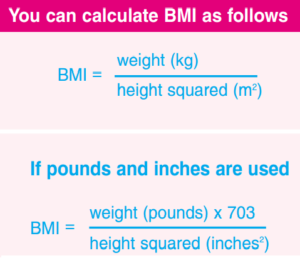BMI ranges
BMI ranges online calculator makes it easier to calculate the relative ratio of weight and height to categorize as normal, overweight or obese. BMI ranges finding is recommended as a practical approach for assessing body fat in the clinical setting. The BMI ranges within which a person’s BMI falls will help determine whether they are of a healthy weight for their height.
BMI Underweight range:
18.5 or below is considered as BMI underweight ranges.
If you are naturally slim then there is no problem at all. But actually being underweight from poor nutrition, or as a result of other disease, can have serious health risks. It must be due to inadequate energy intake or any serious disease and you are feeling tired. This may lead to reduced immunity and you are at risk of severe infections, anaemia, vitamin deficiencies, thinning of the bones, infertility and heart rhythm irregularities. You should discuss it with your doctor. They will make sure you don’t have any illness causing the weight loss and then will advise you about how to safely gain weight.
BMI normal range or BMI healthy range:
BMI ranges of 18.5 to 24.9 suggests a BMI normal or healthy range.
This means your body is not at risk of weight-related disease. You still need to ensure a balanced diet with plenty of fresh fruits, vegetables and good vitamin and mineral intake. On the other hand, if your caloric intake is matching your energy output you will remain normal.
BMI Overweight range:
BMI ranges between 25 to 29.9 is BMI overweight.
The excess weight silently started to damage your blood vessels, hormone system and joints. Eventually raising your risk of diseases such as heart disease, High blood pressure, Diabetes, Arthritis, Infertility, Asthma, Cancer. The effects of overweight can be reversed more easily by gently reducing caloric intake and increasing activity level.
Crash diets don’t work so you need to change your lifestyle. Even slight changes make a difference. For example, two less chocolate biscuits can lose your 5lb of fat during the year. Simply parking the car at the far end of the car park or using the stairs instead of the lift will over time make a noticeable difference.
Sometimes for athletes and sportsmen and women with this BMI is considered normal because they have less fats.
CDC guidelines
BMI Obesity range:
BMI range of 30 to 35 medically classified as obese or as BMI obesity.
This means you’re at high risk of weight-related illness, such as heart disease, High blood pressure, Diabetes, Arthritis, Infertility, Asthma, Cancer. But if you lose even just a little weight your risk will drop. For example, Just a five per cent weight loss (from 80kg to 76kg) significantly reduce health risks associated with obesity, such as reducing cholesterol levels and blood pressure and even better blood sugar control.
BMI range over 35 considers as very obese.
This means that obesity-related illnesses could severely affect the quality of your life and shorten your lifespan by several years. But the good news is it’s not too late to do something about it. If you can lose some weight fasting insulin improves and eventually glycemic control in patients with type 2 diabetes. You can cut down your medication of diabetes and blood pressure. Before taking any decision You should see your doctor and talk about getting help.
BMI ranges 40 or more is ‘morbidly obese’.
You are 80 times more likely to develop type 2 diabetes than someone with a normal BMI and your life is at great risk. Your lifespan is going to be shortened by over ten years and your quality of life will reduce in many ways.
what is BMI ?
BMI is a global index of nutritional status used to categorize both overweight/obesity and eating disorders in combination with psychological criteria. Is also widely used as an index of relative weight. According to CDC guidelines, it provides a more accurate measure of total body fat compared with the assessment of body weight alone.
Body mass index (BMI) is a measure of body fat based on height and weight that applies to adult men and women both. The feeling of being at the top of the game, more energized or physically more active and knowing that we are healthy from inside is wonderful. Doctors use BMI as a screening tool for weight ranges to identify if a person is underweight, healthy, overweight or obese. This tool makes you alert to get out of the couch and do something for your health.
If you are overweight or obese you standing at the door of serious health risks. According to National Heart-lung and Blood Institute U.S, obesity-associated diseases like high blood pressure(hypertension), high LDL cholesterol(“bad” cholesterol), low HDL cholesterol(“good” cholesterol), High triglycerides, high blood glucose (sugar), other factors like Family history of premature heart disease, physically inactive, cigarette smoking will put us at greater risk.
Many researchers recognize that taking small steps to eat better can improve our health. We should be physically more active at any stage of life before gaining too much weight.
BMI formula:
Body mass index or BMI is a mathematical calculation based on height and weight regardless of gender. It does not recognize where the fats are located. Fats in the abdominal region causes more serious problems the fats under the skin called subcutaneous fats.
The founder of this formula was Belgian Mathematician Adolphe Quetelet in 1832. We can calculate it as imperial and metric systems.

We have created online BMI calculator to keep you off from these calculations
Why BMI ranges are important?
This weight to height ratio BMI ranges broadly recognize as a fat assessment method as it is really easy to use. It provides a more rough means of estimating adipose (fatness) and identifying trends of sedentary or overweight individuals. Mostly office workers who’s lifestyle is more sedentary and do not have much time to exercise falls in this category.
This index will indicate your healthy weight ranges and act as a predictor of the risk of diseases.
According to J C K Wells and M S Fewtrell “BMI is predictive of clinical outcomes such as type 2 diabetes Its predictive value for children and adolescents is less clear.
J C K Wells and M S Fewtrell
How to BMI ranges can be calculated without a calculator?
BMI Chart:
Besides that, another common tool as given in Dietary Guidelines U.S. Department of Health and Human Services used as an indicator to determine weight status. e.g., BMI chart. Having height in the left-most column, and then read across the row from your height to your weight. Follow the column of the weight up to top row that lists the BMI ranges.
Limitations of BMI ranges
BMI ranges has some limitations too,
- It over estimates body fat in persons who are muscular.
- According to WHO BMI ranges are age-independent and the same for both sexes.
- BMI may not correspond to the same degree of fatness in different populations due to different body proportions.
- It is not diagnostic of the body fatness or health of an individual. We use it to rank individuals in term of relative “fatness” or to access the size of specific subcutaneous fat deposits along with other expensive techniques and nonavailability for most clinicians.
- We cannot apply body mass index ranges to athletes and bodybuilders who have more weight due to more muscle mass So they need more accuracy from General Physician.
Techniques for measuring body composition
Body composition and growth are key components in determining health in both individuals and populations. Assessment techniques for measuring body composition includes evaluation of body mass index skinfold thickness measurements and waist circumference.
Skinfold thickness measurements
Traditionally, skinfold thickness measurements used to rank individuals in terms of relative “fatness” or to assess the size of specific subcutaneous fat deposits. Measurements are quick and simple to obtain in most age groups including young infants. For adults, it produces fewer errors but in obese children, accuracy and precision is even poorer.
Waist circumference
This provides a simple measure of central fatness. Excess abdominal fat is an important, independent risk factor for the disease. Waist circumference is the most practical tool for a clinician to evaluate patient health, as abdominal fat has greater health risks as compared to peripheral fat. Measurement of waist circumference is useful in patients who are categorized as normal or overweight.
It is not necessary to measure waist circumference in individuals with obese BMI ranges. Men who have waist circumferences greater than 40 inches and women who have waist circumferences greater than 35 inches are at higher risk of diabetes, hypertension, and cardiovascular disease because of excess abdominal fat.
References:
- Measuring body composition J C K Wells and M S Fewtrell Arch Dis Child. 2006 Jul; 91(7): 612–617.PMCID: PMC2082845 Retrieved in September 3, 2026 http://www.ncbi.nlm.nih.gov/pmc/articles/PMC2082845/
- The Practical Guide Identification, Evaluation, and Treatment of Overweight and Obesity in Adults Retrieved on September 3, 2016, http://www.nhlbi.nih.gov/files/docs/guidelines/prctgd_c.pdf
- Adolph Quetelet (1796-1874) The average Man and Indices of Obesity. E Knoyan, G. Retrieved on September 2, 2016, http://www.ncbi.nlm.nih.gov/pubmed/17890752
- https://www.cdc.gov/healthyweight/assessing/bmi/index.html
Disclaimer:
All the information above are only for educational purpose. No piece of writing is above the qualified physician and doctor. Please consult your health care provider for any health conditions.
Have a blessed day!
If you liked this article, then please subscribe to our YouTube Channel for more video recipes. You can also find us on Twitter and Facebook.





17 comments